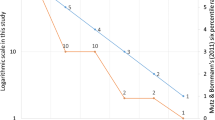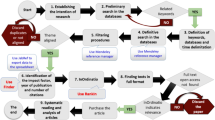Abstract
The h-index and Eigenfactor TM values of top and specialized scientific/engineering journals are tabulated and combined to provide a simple graphical representation of the journals. The information may be tailored to specific uses by respective stakeholders to aid decision making processes with regards to scholarly research and scientific journal publications.


Similar content being viewed by others
References
Bergstrom, C. (2007). Eigenfactor: Measuring the value and prestige of scholarly journals. College and Research Libraries News, 68, 314–316.
Bollen, J., Rodriguez, M. A., & van de Sompel, H. (2006). Journal status. Scientometrics, 69(3), 669–687.
Bornmann, L., Marx, W., & Schier, H. (2009). Hirsch-type index values for organic chemistry journals: A comparison of new metrics with the journal impact factor. European Journal of Organic Chemistry, 10, 1471–1476.
Braun, T., Glanzel, W., & Schubert, A. (2006). A Hirsch-type index for journals. Scientometrics, 69, 169–173.
Fersht, A. (2009). The most influential journals: Impact factor and Eigenfactor. Proceedings of the National Academy of Sciences of United States of America, 106(17), 6883–6884.
Garfield, E. (2006). The history and meaning of the journal impact factor. Journal of the American Medical Association, 295, 90–93.
Glanzel, W. (2006). On the h-index—A mathematical approach to a new measure of publication activity and citation impact. Scientometrics, 67(2), 315–321.
Hirsch, J. E. (2005). An index to quantify an individual’s scientific research output. Proceedings of the National Academy of Sciences of United States of America, 102(46), 16569–16572.
Peters, H. P. F., & van Raan, A. F. J. (1994). A bibliometric profile of top-scientists: A case study in chemical engineering. Scientometrics, 29(1), 115–136.
Schubert, A., & Glänzel, W. (2007). A systematic analysis of Hirsch-type indices for journals. Journal of Informetrics, 1(3), 179–184.
Spearman, C. (1904). The proof and measurement of association between two things. The American Journal of Psychology, 15, 72–101.
Taber, D. F. (2005). Quantifying publication impact. Science, 309, 2166.
Van Raan, A. F. J. (2006). Comparison of the Hirsch-index with standard bibliometric indicators and with peer judgment. Scientometrics, 67(3), 491–502.
Yu, G., & Wang, L. (2007). The self-cited rate of scientific journals and the manipulation of their impact factors. Scientometrics, 73(3), 321–330.
Author information
Authors and Affiliations
Corresponding author
Rights and permissions
About this article
Cite this article
Yin, CY., Aris, M.J. & Chen, X. Combination of Eigenfactor TM and h-index to evaluate scientific journals. Scientometrics 84, 639–648 (2010). https://doi.org/10.1007/s11192-009-0116-9
Received:
Published:
Issue Date:
DOI: https://doi.org/10.1007/s11192-009-0116-9




